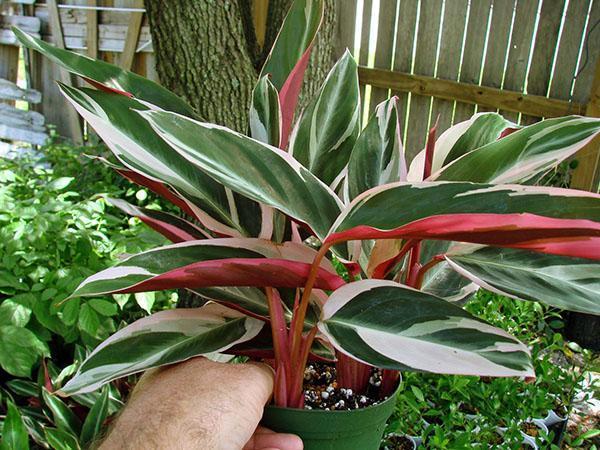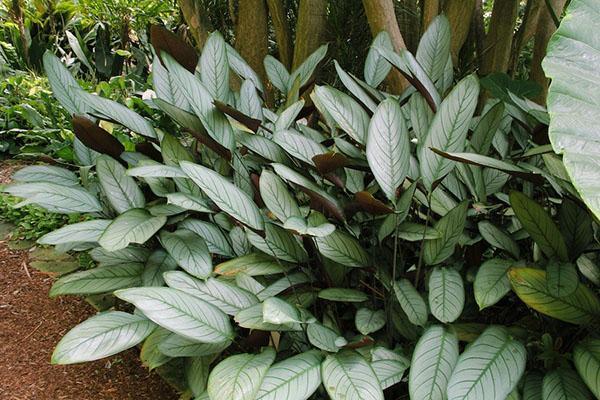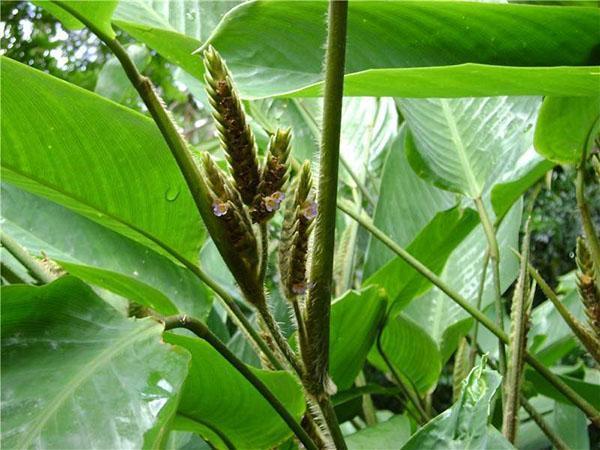Photo ktenants and home care
 Plants with variegated decorative foliage are gaining more and more attention from indoor crop lovers. Not an exception - the ktenant shown in the photo, caring for which at home will require some knowledge, but it will bring a lot of pleasure and interesting observations.
Plants with variegated decorative foliage are gaining more and more attention from indoor crop lovers. Not an exception - the ktenant shown in the photo, caring for which at home will require some knowledge, but it will bring a lot of pleasure and interesting observations.
Ktenanta, or, as the name of the culture in Latin sounds, Ctenanthe, comes from the tropical regions of the South American continent. A herbaceous plant with oval leaves sitting on elongated petioles and surprising variegation of colors, belongs to the Marantov family.

Descriptions and photos of species ktenants
Like most plants of the family, ktenants have large whole leaves of an oval or slightly pointed shape. An adult plant forms a powerful herbaceous bush, consisting of erect or lodging stems. Leaves are attached to the shoots with the help of long petioles, and due to the structural features they grow unevenly, but in bunches. Leaf plates are rarely monochromatic.
Most species of ctenants, as in the photo, are variegated. They can be recognized by their original light green, silver or yellow-green strokes, ornaments or stripes that radiate from the middle vein to the edges.
When caring for a ktenant, many growers note not only the beauty of the foliage, but also its mobility. Depending on the light, the leaves of this tropical species are capable of rising or falling.
 If the foliage of the plant is undoubtedly decorative, then the flowering of the ktenants, in the photo, may not be noticed. Small spike-shaped inflorescences, on which white, yellowish or lilac flowers open, emerge from the leaf sinuses.
If the foliage of the plant is undoubtedly decorative, then the flowering of the ktenants, in the photo, may not be noticed. Small spike-shaped inflorescences, on which white, yellowish or lilac flowers open, emerge from the leaf sinuses.
In nature, there are 17 species belonging to the genus Ctenanthe. These crops vary in size, habitat and leaf patterns, but have similar growing conditions and care preferences. Today, only a few, the most spectacular species are used as indoor and garden, ornamental crops.
 Quite graceful, up to half a meter high, ctenant Berl-Marx (Ctenanthe burle-marxii) fell in love with flower growers due to oval light green or silvery leaves, the pattern on which resembles a branch running along the central vein. The leaves themselves are oval, about 10 cm long and 4 to 6 cm wide. If their upper side is patterned, then the back has a beautiful, but uniform purple color.
Quite graceful, up to half a meter high, ctenant Berl-Marx (Ctenanthe burle-marxii) fell in love with flower growers due to oval light green or silvery leaves, the pattern on which resembles a branch running along the central vein. The leaves themselves are oval, about 10 cm long and 4 to 6 cm wide. If their upper side is patterned, then the back has a beautiful, but uniform purple color.
 The inflorescences appearing at the tops of the shoots are painted in the tone of the foliage, and the small flowers are light cream in color.
The inflorescences appearing at the tops of the shoots are painted in the tone of the foliage, and the small flowers are light cream in color.
 Much larger than the previous species of Ctenanthe lubbersiana. Lovers of large domestic plants will appreciate well leafy bushes up to 70-80 cm high.
Much larger than the previous species of Ctenanthe lubbersiana. Lovers of large domestic plants will appreciate well leafy bushes up to 70-80 cm high.
The leaves of this species of ktenants, as in the photo, have an oblong-oval shape and a double-sided green color, on which chaotic yellow or light green strokes from the midvein at the edge of the leaf plate stand out brightly.
 In a potted culture, Ctenanthe oppenheimiana grows up to a meter tall, forming beautiful wide bushes with many oblong-pointed leaves. This species of ktenants, as in the photo, has the most unusual foliage of all the described plants.
In a potted culture, Ctenanthe oppenheimiana grows up to a meter tall, forming beautiful wide bushes with many oblong-pointed leaves. This species of ktenants, as in the photo, has the most unusual foliage of all the described plants.
 Not only is there a pattern of dark and light green stripes on the upper side of the leaf plate, and the lower surface is painted in a raspberry-burgundy hue. In some plants, asymmetrical white or pinkish, wide strokes also extend to the patterned side.
Not only is there a pattern of dark and light green stripes on the upper side of the leaf plate, and the lower surface is painted in a raspberry-burgundy hue. In some plants, asymmetrical white or pinkish, wide strokes also extend to the patterned side.
 The ctenant shown in the photo, or compressa, has green leaves up to 35–40 centimeters long.
The ctenant shown in the photo, or compressa, has green leaves up to 35–40 centimeters long.
This is one of the most powerful species, so the plant is used in greenhouse landscaping, winter gardens or hallways of public buildings. The culture blooms, forming spike-shaped, almost non-decorative inflorescences in length.
Caring for a ktenant at home
Like all green inhabitants of the tropics, ktenants love warmth and are sensitive to temperature extremes. When caring for a ktenant, it is enough to maintain a comfortable room temperature for them in the range of 22-25 ° C during the day, and a couple of degrees cooler at night. In winter, plants also do not need special conditions. Ktenanta winters well at 18–20 ° C with a slight drop in temperature at night.
If in the warm season the plant is taken out into the open air, it is necessary to ensure that the culture does not suffer from frost at night, and also take care of protection from the cold wind.
Caring for a ktenant at home will not give positive results if the wrong place is selected for the plant. In nature, this culture grows under the canopy of taller plants, therefore, in the house it should not be exposed to the bright direct rays of the sun. But even in deep shade, you should not wait for decorative foliage and crown density. The best place for ktenants, in the photo, is a transparent partial shade, and the duration of daylight hours should not be less than 14-16 hours. In the middle lane, the last condition for caring for a ktenant can be fulfilled only with the help artificial backlight.
 Ktenante needs increased air humidity, if the room is too dry, the plant signals the curling and wilting of the foliage. Therefore, in caring for a ktenant at home, as in the photo, irrigation of the crown with water and processing the leaves with a damp napkin must be included.
Ktenante needs increased air humidity, if the room is too dry, the plant signals the curling and wilting of the foliage. Therefore, in caring for a ktenant at home, as in the photo, irrigation of the crown with water and processing the leaves with a damp napkin must be included.
Watering is carried out as the soil surface dries. In the summer, it is necessary to moisten the soil more often and more abundantly, and from autumn to spring, when the life processes in the plant are slowed down, watering is limited. For the same reason, in winter, the ktenante does not need additional feeding, and excess water is extremely dangerous for the roots and the entire plant as a whole.
With the arrival of spring, in addition to watering, the indoor culture must be fed using complex formulations. When caring for a ktenant at room conditions, it is convenient to apply liquid products along with watering, using half the concentration of fertilizer.
 The root system of young plants always develops more intensively than in adults, so such specimens need an annual transplant. It is not worth disturbing larger plants in vain, they are transferred into a new pot as the roots grow and they develop the entire volume of soil. The procedure is carried out in the second half of spring, choosing wide containers for transplanting and providing the ktenante with powerful drainage.
The root system of young plants always develops more intensively than in adults, so such specimens need an annual transplant. It is not worth disturbing larger plants in vain, they are transferred into a new pot as the roots grow and they develop the entire volume of soil. The procedure is carried out in the second half of spring, choosing wide containers for transplanting and providing the ktenante with powerful drainage.
The best soil for an inhabitant of the tropics is a nutritious, moderately loose mixture of garden soil and two smaller volumes of peat and sand. It is useful to add pre-crushed sphagnum and charcoal to the substrate.
With proper care at home, the ktenant, as in the photo, pleases the owner for a long time with the brightness of the color of the leaves, their constant growth and abundance.